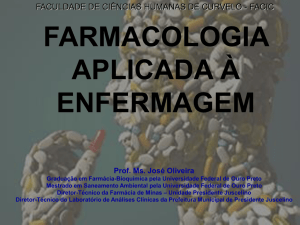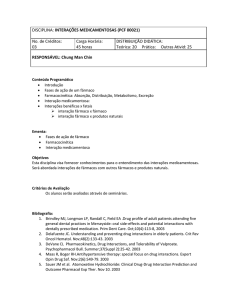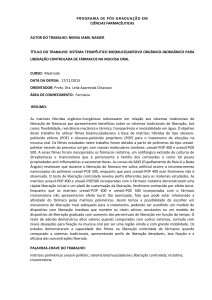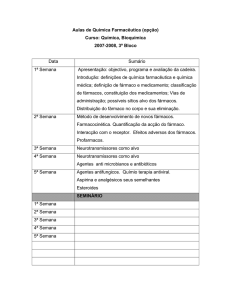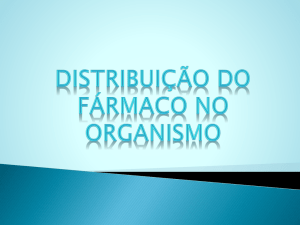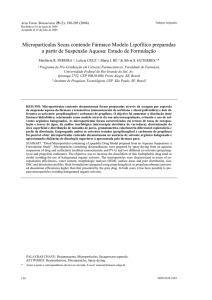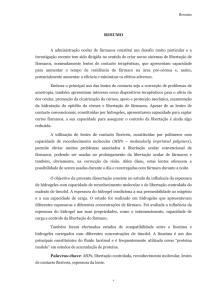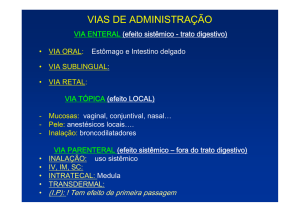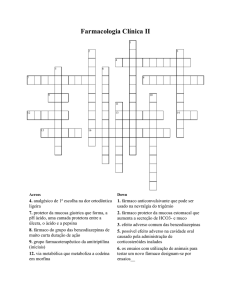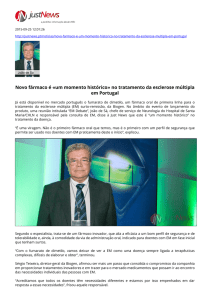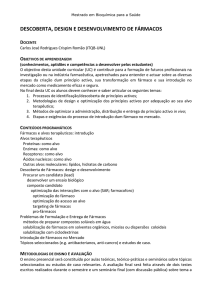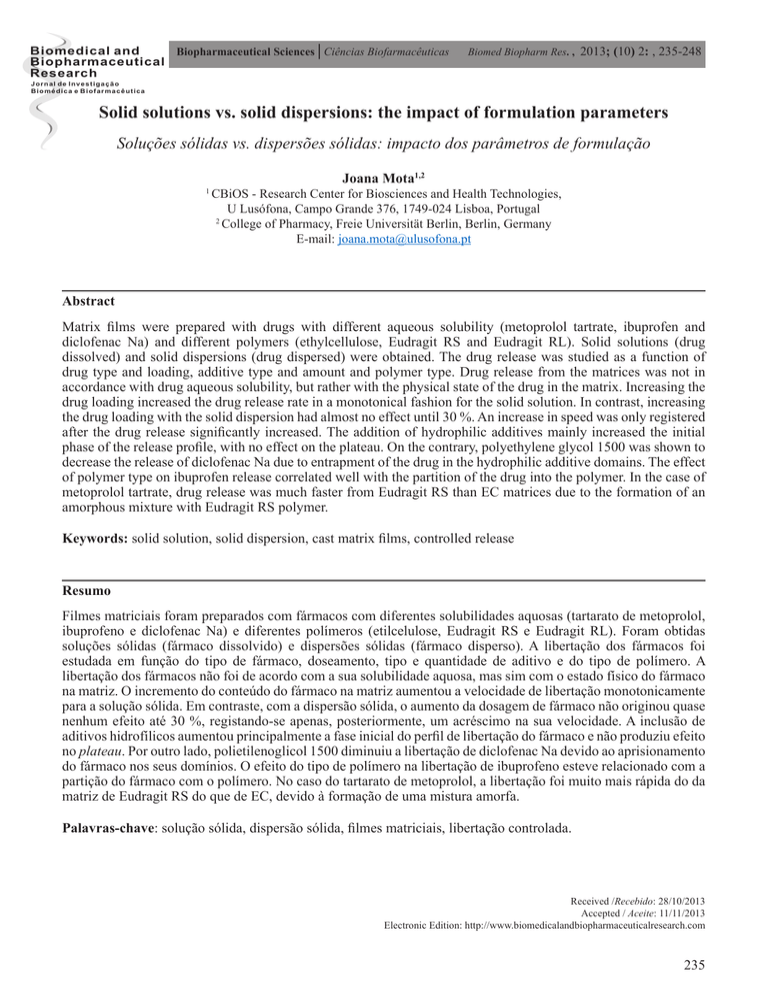
Biomedical and
Biopharmaceutical Sciences│Ciências Biofarmacêuticas
Biopharmaceutical
Research
Biomed Biopharm Res. , 2013; (10) 2: , 235-248
Jornal de Investigação
Biomédica e Biofarmacêutica
Solid solutions vs. solid dispersions: the impact of formulation parameters
Soluções sólidas vs. dispersões sólidas: impacto dos parâmetros de formulação
1
Joana Mota1,2
CBiOS - Research Center for Biosciences and Health Technologies,
U Lusófona, Campo Grande 376, 1749-024 Lisboa, Portugal
2
College of Pharmacy, Freie Universität Berlin, Berlin, Germany
E-mail: [email protected]
Abstract
Matrix films were prepared with drugs with different aqueous solubility (metoprolol tartrate, ibuprofen and
diclofenac Na) and different polymers (ethylcellulose, Eudragit RS and Eudragit RL). Solid solutions (drug
dissolved) and solid dispersions (drug dispersed) were obtained. The drug release was studied as a function of
drug type and loading, additive type and amount and polymer type. Drug release from the matrices was not in
accordance with drug aqueous solubility, but rather with the physical state of the drug in the matrix. Increasing the
drug loading increased the drug release rate in a monotonical fashion for the solid solution. In contrast, increasing
the drug loading with the solid dispersion had almost no effect until 30 %. An increase in speed was only registered
after the drug release significantly increased. The addition of hydrophilic additives mainly increased the initial
phase of the release profile, with no effect on the plateau. On the contrary, polyethylene glycol 1500 was shown to
decrease the release of diclofenac Na due to entrapment of the drug in the hydrophilic additive domains. The effect
of polymer type on ibuprofen release correlated well with the partition of the drug into the polymer. In the case of
metoprolol tartrate, drug release was much faster from Eudragit RS than EC matrices due to the formation of an
amorphous mixture with Eudragit RS polymer.
Keywords: solid solution, solid dispersion, cast matrix films, controlled release
Resumo
Filmes matriciais foram preparados com fármacos com diferentes solubilidades aquosas (tartarato de metoprolol,
ibuprofeno e diclofenac Na) e diferentes polímeros (etilcelulose, Eudragit RS e Eudragit RL). Foram obtidas
soluções sólidas (fármaco dissolvido) e dispersões sólidas (fármaco disperso). A libertação dos fármacos foi
estudada em função do tipo de fármaco, doseamento, tipo e quantidade de aditivo e do tipo de polímero. A
libertação dos fármacos não foi de acordo com a sua solubilidade aquosa, mas sim com o estado físico do fármaco
na matriz. O incremento do conteúdo do fármaco na matriz aumentou a velocidade de libertação monotonicamente
para a solução sólida. Em contraste, com a dispersão sólida, o aumento da dosagem de fármaco não originou quase
nenhum efeito até 30 %, registando-se apenas, posteriormente, um acréscimo na sua velocidade. A inclusão de
aditivos hidrofílicos aumentou principalmente a fase inicial do perfil de libertação do fármaco e não produziu efeito
no plateau. Por outro lado, polietilenoglicol 1500 diminuiu a libertação de diclofenac Na devido ao aprisionamento
do fármaco nos seus domínios. O efeito do tipo de polímero na libertação de ibuprofeno esteve relacionado com a
partição do fármaco com o polímero. No caso do tartarato de metoprolol, a libertação foi muito mais rápida do da
matriz de Eudragit RS do que de EC, devido à formação de uma mistura amorfa.
Palavras-chave: solução sólida, dispersão sólida, filmes matriciais, libertação controlada.
Received /Recebido: 28/10/2013
Accepted / Aceite: 11/11/2013
Electronic Edition: http://www.biomedicalandbiopharmaceuticalresearch.com
235
Joana Mota
Introduction
Introdução
Coated multiparticulates may be formulated as matrix and reservoir systems. In coated matrix systems,
the pellets are coated with a drug and polymer solution
whereas in reservoir systems the pellets are first coated
with a drug layer and after with a polymer solution. Matrix coated systems present several advantages: they are
easy to manufacture and low in cost (1 step process),
there is a lower risk of dose dumping (if the coating
accidentally ruptures) and there is the possibility of improving the aqueous drug solubility. Furthermore, drugpolymer interactions can occur and these bring benefits
in terms of mechanical properties such the plasticizing
effect. [1, 2] The main disadvantages include fast initial
release [3] and incomplete release in a defined time.
In a matrix system the drug and polymer are dissolved
or dispersed in a common solvent and upon solvent
evaporation, a solid solution (drug dissolved in the
polymer) or a solid dispersion (drug dispersed in the
polymer) or a combination of both is obtained.
The objective of this study is to identify the key parameters affecting drug release from solid solutions and
solid dispersions in cast films, in order to predict the
release from matrix-coated pellets.
Sistemas multiparticulados revestidos podem ser formulados como sistemas matriciais ou reservatórios.
Nos sistemas com revestimento matricial, os pellets
são revestidos por uma solução de fármaco e polímero, enquanto nos sistemas reservatório os pellets são
revestidos, primeiramente, por uma camada de fármaco
e, posteriormente, por uma camada de polímero. Os
primeiros apresentam diversas vantagens, como fácil
fabrico e baixo custo (1 passo no processo), menor risco
de libertação descontrolada (ruptura da membrana) e a
possibilidade de aumento da solubilidade aquosa do
fármaco. Além disso, interacções fármaco-polímero
podem ocorrer e trazer benefícios em termos de propriedades mecânicas, entre as quais se destaca o efeito
plasticizante [1, 2] As principais desvantagens incluem a
libertação inicial rápida [3]e a libertação incompleta.
Num sistema matricial, o fármaco e o polímero são
dissolvidos ou dispersos num solvente comum e, após
evaporação do solvente, uma solução sólida (fármaco
dissolvido no polímero) ou uma dispersão sólida (fármaco disperso no polímero) – ou, então, uma combinação de ambos – é obtida.
O objetivo deste estudo é identificar os principais
parâmetros que afectam a libertação do fármaco a partir de soluções sólidas e dispersões sólidas em filmes
(membranas matriciais), para poder prever a libertação
de pellets revestidos por matrizes.
Material and Methods
Materiais e Métodos
Materials
Materiais
Metoprolol tartrate (Moehs, Barcelona, Spain), diclofenac sodium (Farchemia, Treviglio, Italy) and ibuprofen (BASF AG, Germany), hydroxypropylmethylcellulose (HPMC) (Methocel E5, Colorcon, England),
hydroxypropylcellulose (HPC) (Klucel EXF and JF,
Hercules GmbH, Germany), povidone K90 (BASF AG,
Germany), polyethylene glycol (PEG) 1500 (Lutrol E,
Germany), ethylcellulose (Ethocel Standard premium
10, DOW Chemical Company, USA), ammonio methacrylate copolymer type A (Eudragit RS) and ammonio methacrylate copolymer type B (Eudragit RS). All
other chemicals were of reagent analytical grade.
Tartarato de metoprolol (Moehs, Espanha), diclofenac
Na (Farchemia, Itália) e ibuprofeno (BASF AG, Alemanha), hidroxipropilmetilcelulose (HPMC) (Methocel E5, Colorcon, Reino Unido), hidroxipropilcelulose
(HPC) (Klucel EXF e JF, Hercules GmbH, Alemanha),
polivinilpirrolidona (BASF AG, Alemanha), polietilenoglicol (PEG) 1500 (Lutrol E, Alemanha) etilcelulose
(Ethocel Standard premium 10, DOW Chemical Company, EUA), copolímero de metacrilato de amónio tipo
A (Eudragit RL) e tipo B (Eudragit RS). Os restantes
reagentes foram de grau analítico
Preparation of cast matrix films
Matrix films were prepared by dissolving diclofenac
Na (30 cg/g), ibuprofen (between 10 cg/g and 50 cg/g)
and metoprolol tartrate (between 10 cg and 50 cg/g) in
isopropanol: water, in the respective proportion 88 g:
12 g. After the addition of the polymer (ethylcellulose,
6 cg/g; Eudragit RS and Eudragit RL, 10 cg/g), HPC
236
Preparação de filmes matriciais
Os filmes matriciais foram preparados por dissolução
do diclofenac Na (30 cg/g), ibuprofeno (entre 10 cg/g
e 50 cg/g) e tartarato de metoprolol (entre 10 cg/g e
50 cg/g) em álcool isopropílico: água, na respectiva
proporção 88 g: 12 g). Depois da adição e dissolução
dos polímeros (etilcelulose, 6 cg/g; Eudragit RS e Eudragit RL, 10 cg/g), HPC JF, PVP K90, manitol entre 7
Solid solutions vs. solid dispersions
Soluções sólidas vs. dispersões sólidas
JF, PVP K90, manitol, between 7 cg/ and 28 cg/g and
PEG 1500, between 6 cg/g and 30 cg/g were optionally
added. After overnight stirring, matrix solutions/dispersions were cast on petri dishes, covered with paper and
dried at room temperature for 2 days. The thickness of
the films was measured using thickness gauge (Minitest
600, Erichsen, Hemer, Germany).
Drug release from matrix films
The edges of the films were sealed with vaseline to
avoid drug diffusion through the film ends. Drug release
was conducted in 900 ml (diclofenac Na and ibuprofen) and 500 ml (metoprolol tartrate) phosphate buffer
pH 6,8 (75 rpm, 37 °C, n = 3) in a horizontal shaker
(GFL 3033). At predetermined time intervals, 3 ml samples were withdrawn and analyzed (directly or after
appropriate dilution) with Shimadzu UV-2101PC UVVis Scanning spectrophotometer (Shimadzu Europe,
Germany) giving the following results: diclofenac Na,
λ = 275 nm; ibuprofen, λ = 264 nm; metoprolol tartrate,
λ = 274 nm. The osmolality was determined based on the
freezing point of the solutions compared to pure water.
cg/ e 28 cg/g e PEG 1500 entre 6 cg/g e 30 cg/gforam
opcionalmente adicionados. Após agitação durante
a noite, as soluções e dispersões foram colocadas em
caixas de petri, cobertas com papel secas à temperatura
ambiente (2 dias). A espessura dos filmes foi medida
(Minitest 600, Erichsen, Hemer, Alemanha).
Ensaio de libertação in vitro
Os bordos dos filmes foram selados com vaselina para
evitar difusão dos fármacos através da orla dos filmes. O
ensaio foi realizado com 900 ml (diclofenac Na e ibuprofeno) e 500 ml (tartarato de metoprolol) em tampão fosfato pH 6,8 (75 rpm, 37 °C, n = 3), numa incubadora com
agitação horizontal (GFL 3033). Em intervalos de tempo
pré-determinados, foram retiradas amostras de 3 ml e analisadas (directamente ou após diluição apropriada) num
espectrofotómetro UV-visível (Shimadzu UV-2101PC
UV-Vis Scanning spectrophotometer; Shimadzu Europe,
Alemanha). Diclofenac Na, λ = 275 nm; ibuprofeno,
λ= 264 nm e tartarato de metoprolol, λ = 274 nm. A osmolalidade foi determinada através da medida do ponto
de congelamento da solução em comparação com a água.
Solubility measurements
Excess amounts of diclofenac Na and ibuprofen were
placed in contact with phosphate buffer pH 6,8 in a
horizontal shaker (GFL 3033) (75 rpm, 37 °C, n = 3)
for at least 72 h. Every 24 h, samples were withdrawn,
filtered and the pH of the saturated solution was adjusted with sodium hydroxide solution. The samples were
then analyzed for the drug content after equilibrium
was reached.
Determinação da solubilidade
Uma quantidade em excesso de diclofenac Na e ibuprofeno foi colocada em tampão fosfato pH 6,8 (75 rpm,
37°C, n = 3) numa incubadora com agitação horizontal (GFL 3033) pelo menos durante 72 h. A cada 24 h
foram recolhidas amostras, filtradas e o pH das soluções
saturadas foi ajustado com uma solução de hidróxido
de sódio. As amostras foram analisadas directamente
ou, após diluição, num espectrofotómetro UV-visível
(Shimadzu UV-2101PC UV-Vis Scanning spectrophotometer; Shimadzu Europe, Alemanha).
Determination of the drug content
The residual drug content in the films was determined
after extraction in ethanol (96 %) for selected samples
(diclofenac Na, λ= 282 nm; ibuprofen, λ= 264 nm; metoprolol tartrate, λ= 276 nm).
Determinação do conteúdo de fármaco
A quantidade residual de fármaco nos filmes foi determinada após extracção em etanol (96 %) com amostras
selecionadas (diclofenac Na, λ= 282 nm; ibuprofeno,
λ= 264 nm; tartarato de metoprolol, λ= 276 nm).
Drug partition into polymer
Ibuprofen partition into ethylcellulose, Eudragit RS
and Eudragit RL was determined as follows: a known
amount of the drug was dissolved in a known amount
of phosphate buffer pH 6,8. Accurately weighed polymer was added to the drug solution and stirred over a
period of 24 h (75 rpm, 37°C, n = 3) in a horizontal
shaker (GFL 3033). 3 ml samples were withdrawn and
analyzed (directly or after appropriate dilution) with
UV spectrophotometry (Shimadzu UV-2101PC UV-Vis
Scanning spectrophotometer; Shimadzu Europe, Germany).
Drug partition into the polymer was calculated as follows:
where Ci is the initial drug concentration and Cf is the
final drug concentration.
Coeficiente de partição entre o fármaco e polímero
A partição do fármaco para etilcelulose, Eudragit RS e Eudragit RL foi determinada como se segue: uma quantidade
conhecida de fármaco foi dissolvida numa quantidade conhecida de tampão fosfato pH 6,8. Uma quantidade rigorosamente pesada de polímero foi adicionada à solução anterior
e deixada em agitação durante 24 h (75 rpm, 37 °C, n = 3)
numa incubadora horizontal (GFL 3033). Amostras de 3 ml
foram retiradas e analisadas (directamente ou após diluição
apropriada) num espectrofotómetro UV-visível (Shimadzu
UV-2101PC UV-Vis Scanning spectrophotometer; Shimadzu
Europe, Alemanha).
O coeficiente de partição do fármaco para o polímero
foi determinado:
Ci corresponde à concentração inicial de fármaco e Cf
corresponde à concentração final
237
Joana Mota
Differential scanning calorimetry (DSC)
Thermograms of PEG 1500, ethylcellulose, diclofenac
Na, matrices of ethylcellulose: diclofenac Na 60:40
(cast film and physical mixture) with and without PEG
1500, were obtained by differential scanning calorimetry (Mettler DSC 821) and STAR software (Mettler
Toledo, Giessen, Germany) to determine the melting
point. The samples (between 10 mg and 20 mg) were
sealed in aluminum pans. All tests were run under a nitrogen atmosphere at a scanning rate of 5 °C/min over a
temperature range of 0 °C to 80 °C.
Calorimetria diferencial de varrimento
Termogramas de PEG 1500, etilcelulose, diclofenac
Na, matrizes de etilcelulose:diclofenac Na 60:40 (filme
e mistura física) com e sem PEG 1500 foram obtidos
por calorimetria diferencial de varrimento (Mettler
DSC 821) e STAR software (Mettler Toledo, Alemanha). Amostras (entre 10 mg e 20 mg) foram seladas
em pequenos recipientes de alumínio. Todos os testes
foram conduzidos sob atmosfera de nitrogénio a uma
velocidade de varrimento de 5 °C/min e num intervalo
de temperaturas de 0 oC a 80 °C.
Microscopic analysis
Matrix films were analyzed by polarizing light microscopy. The microscope was equipped with an imaging
system (EasyMeasure; INTEQ Informationstechnik,
Germany).
Análise microscópica
Os filmes foram analisados por microscopia de luz polarizada (EasyMeasure; INTEQ Informationstechnik,
Alemanha).
Results and Discussion
Resultados e Discussão
Effect of drug type
Efeito do tipo de fármaco
Drug release from ethylcellulose (EC) matrix films was
in the following order: diclofenac Na> ibuprofen> metoprolol tartrate (Fig. 1). Interestingly, the ranking order
of the observed release rates did not follow the ranking
order of aqueous solubility (metoprolol tartrate, 3630
mg/ml [1]>> ibuprofen, 11,1 mg/ml> diclofenac Na, 1.0
mg/ml). In addition, drug solubility in the matrix was as
follows: ibuprofen, 50 cg/g > diclofenac Na, 10 cg/g >
metoproplol tartrate, 5 cg/g (determined by the occur-
A libertação dos fármacos da matriz de etilcelulose foi
na seguinte ordem: diclofenac Na > ibuprofeno > tartarato de metoprolol (Fig. 1). Curiosamente, esta ordem
não está de acordo com a ordem da solubilidade aquosa
(tartarato de metoprolol, 3630 mg/ml [1]>> ibuprofeno,
11,1 mg/ml > diclofenac Na, 1.0 mg/ml). Além disso, a
solubilidade do fármaco na matriz foi: ibuprofeno, 50
cg/g > diclofenac Na, 10 cg/g > metoproplol tartrate,
5 cg/g (determinado pela ocorrência de cristais de fár-
diclofenac Na
ibuprofen
metoprolol tartrate
drug released, %
100
75
50
25
0
0
6
12
18
24
time, h
Figure 1 - Effect of drug type on release from ethylcellulose matrix systems (30 cg/g drug loading)
Figura 1 - Efeito do tipo de fármaco na libertação a partir de sistemas matriciais de etilcelulose (30 cg/g de dosagem)
238
Solid solutions vs. solid dispersions
Soluções sólidas vs. dispersões sólidas
rence of drug crystals in the cast film). As an example,
at 30 % drug loading, diclofenac Na was dissolved and
dispersed (large crystals on matrix surface), ibuprofen
was completely dissolved (absence of any crystal) and
metoprolol tartrate was mainly dispersed in the matrix
(small crystals) (Fig. 2). The fast release of diclofenac
Na was attributed to rapid dissolution and release of
drug crystals. Due to the high solubility of ibuprofen in
the matrix, diffusion through the matrix was the mechanism controlling drug release. Metoprolol tartrate, although a very high soluble drug, was released very
slowly due to drug entrapment in the matrix.
a)
maco na matriz). Por exemplo, para uma dosagem de
30 %, o diclofenac de Na está dissolvido e disperso
(grandes cristais na superfície da matriz), o ibuprofeno
está completamente dissolvido (ausência de cristais) e
tartarato de metoprolol está essencialmente disperso na
matriz (Fig. 2). A libertação rápida de diclofenac Na
foi resultado de uma rápida dissolução e libertação dos
cristais de fármaco. Devido à elevada solubilidade do
ibuprofeno no polímero, a difusão através da matriz foi
o mecanismo de controlo da libertação. No caso do tartarato de metoprolol, a libertação foi muito lenta devido
ao seu aprisionamento na matriz, muito embora o fármaco apresente uma elevada solubilidade aquosa.
b)
c)
Figure 2 – Polarizing light microscope images from ethylcellulose matrix cast films
(30 % drug loading). a) diclofenac Na, b) ibuprofen and c) metoprolol tartrate
Figura 2 – Imagens de microscopia de luz polarizada de filmes matriciais de etilcelulose
(30 % de dosagem de fármaco). a) diclofenac Na, b) ibuprofeno e c) tartarato de metoprolol
Effect of drug loading
Efeito da dosagem
Solid solution
Solução sólida
Drug release increased monotonically with increased
drug loading due to the higher amount of drug able to
diffuse in the matrix (Fig 3a). Ibuprofen release could
be linearly described by a square root of time relationship, indicating a diffusion-controlled mechanism (Fig.
3b). Once the drug was dissolved (solid solution), drug
diffusion occurred through the polymer for all drug
loadings and a constant drug release rate (determined
by the slope of the linear portion of the curve of cumulative amount of drug release, versus square root of
time) increased in direct proportion to the drug concentration, except with the lowest drug loading (Fig. 3c).
The amount of ibuprofen remaining in the matrix at 24h
was plotted against the initial drug loading and a linear
relationship was also obtained. The amount of the drug
not released was directly correlated with initial loading.
By extrapolation of the curve, approximately 65 cg/g
ibuprofen loading is necessary to achieve complete release (Fig. 3d). On the other hand, it is clear from Fig.
A libertação do ibuprofeno aumentou monotonicamente com o incremento da dosagem, devido à maior
quantidade de fármaco capaz de difundir (Fig. 3a). A
libertação do ibuprofeno pode ser linearmente descrita em função da raiz quadrada do tempo, o que indica
um mecanismo controlado por difusão. Uma vez que
o fármaco está dissolvido, a difusão pura através do
polímero ocorre para todas as dosagens e a velocidade
de libertação do fármaco (determinada pelo declive da
porção linear da curva da quantidade cumulativa de libertação do fármaco versus a raiz quadrada do tempo)
aumenta numa proporção directa com a concentração
do fármaco, excepto para a menor dosagem (Fig. 3c). A
quantidade de ibuprofeno restante na matriz às 24h foi
representada graficamente em relação à dosagem inicial e uma relação linear também foi obtida. A quantidade de fármaco não libertado é directamente proporcional à dosagem inicial. Por extrapolação da curva, era
necessário, aproximadamente, uma dosagem de 65 cg/g
239
Joana Mota
3a that increasing the drug loading to 65 cg/g would
also increase the initial drug release.
a)
de ibuprofeno para alcançar uma libertação completa
(Fig. 3d). Por outro lado, é evidente, a partir da Fig. 3a,
que o aumento da dosagem para 65 cg/g iria aumentar a
velocidade inicial de fármaco.
b)
50:50
50:50
60:40
60:40
70:30
80:20
3
75
50
25
0
0
6
12
18
2
1
0
24
0
time, h
1
2
3
4
5
40
50
time, (h)-1/2
c)
d)
1.5
100
drug in film after 24h release, %
K, mg/cm2/(h)1/2
70:30
90:10
drug released, mg/cm2
drug released, %
4
80:20
100
1.0
0.5
0.0
75
50
25
0
0
10
20
30
(drug concentration, mg/cm3)-1/2
40
0
10
20
30
drug concentration, %
Figure 3 – Effect of ibuprofen loading on ethylcellulose matrix cast films. a) drug release, %, b) drug release, mg/cm2
vs.(t)-1/2, c) release rate constant , (K) mg/cm2/(h)-1/2 and d) drug remaining in the matrix at 24 h, %.
Figura 3 – Efeito do aumento da dosagem de ibuprofeno em filmes matriciais de etilcelulose. a) libertação do fármaco,%,
b) libertação do fármaco, mg/cm2 vs.(t)-1/2, c) constante de libertação (K), mg/cm2/(h)-1/2 e d) fármaco restante na matriz após
24h, %
240
Solid solutions vs. solid dispersions
Soluções sólidas vs. dispersões sólidas
Solid dispersion
Dispersão sólida
Metoprolol tartrate release was very low up to 30% of
drug loading and then increased with increasing drug
loading. However, complete release was not reached
(Fig. 4a). Drug release could be described by a square
A libertação de tartarato de metoprolol foi muito baixa
até 30% de dosagem inicial e posteriormente aumentou
com o incremento de dosagem de fármaco. No entanto,
a libertação completa não foi alcançada (Fig. 4a). A lib-
a)
50:50
60:40
70:30
80:20
90:10
b)
50:50
60:40
70:30
4
80:20
100
90:10
drug released, mg/cm2
drug released, %
3
75
50
25
0
2
1
0
0
6
12
18
24
0
1
2
time, h
c)
4
5
d)
100
drug in film after 24h release, %
1.5
K, mg/cm2/(h)1/2
3
time, (h)-1/2
1.0
0.5
75
50
25
0
0.0
0
10
20
30
(drug concentration, mg/cm3)-1/2
40
0
10
20
30
40
50
drug concentration, %
Figure 4 - Effect of metoprolol tartrate loading on ethylcellulose matrix cast films. a) drug release, %, b) drug release, mg/
cm2vs. (t)-1/2, c) release rate constant (K), mg/cm2/(h)-1/2 and d) drug remaining in the matrix at 24h, %.
Figura 4 - Efeito do aumento da dosagem de tartarato de metoprolol em filmes matriciais de etilcelulose. a) libertação do
fármaco, %, b) libertação do fármaco, mg/cm2 vs. (t)-1/2, c) constante de libertação (K), mg/cm2/(h)-1/2 e d) fármaco restante
na matriz após 24h, %.
241
Joana Mota
root of time relationship, indicating a diffusion controlled mechanism (Fig. 4b). In this case, because the
drug is dispersed in the matrix, diffusion occurred
through water filled pores. The release rate showed a
positive deviation from linearity (Fig. 4c). From the
plot of the drug remaining in the matrix at 24h against
drug loading, an inflexion point could be determined
around 30% drug loading (Fig. 4d). This result showed
that other parameters (like porosity) change with drug
loading but not in a proportional fashion. The release
mechanism could be explained as follows: at low drug
loadings (< 30% drug loading), pores randomly situated in the matrix are not interconnected and most of
the drug is entrapped in the matrix with no diffusion
and release possible. When drug loading increases
above a critical value (> 30% drug loading) pores start
to interconnect to form a wet porous network and drug
release occurs via diffusion through water filled pores.
This critical drug loading is known as the percolation
threshold [4]. Therefore, only the drug particles accessible to the outside medium through the porous network will contribute to diffusion in the matrix. In other
words, isolated drug particles cannot contribute to the
transport. When a drug cannot access the matrix surface
through the wet pore network, it will not be released.
As a result the drug release is slower than predicted,
considering aqueous diffusion.
Effect of additives
Solid solution
In order to achieve complete drug release from matrix
cast films, HPC JF and PVP K90 were used as hydrophilic additives. Increasing HPC JF and PVP K90 content, increased release in similar trend (Fig. 5a and b).
Additive content of 7% and 14% showed almost no effect of ibuprofen release rate, probably due to similar
drug diffusion through the matrices (drug dissolved in
the polymers). At 21% and 28% of additive, the drug
release rate significantly increased (Fig. 5c) due to matrix erosion during drug release studies. This erosion,
caused by the additive leaching, shortened the path
length for the drug diffusion, increased surface area and
the drug release increased.
242
ertação do fármaco pode ser descrita pela raiz quadrada
do tempo, o que indica um mecanismo de difusão (Fig.
4b). Neste caso, como o fármaco está disperso, a difusão
ocorre através de poros/canais. A velocidade de libertação revelou um desvio positivo à linearidade (Fig.
4c). Através do gráfico de fármaco retido na matriz às
24h em função da dosagem, um ponto de inflexão pode
ser determinado em torno de 30% de fármaco (Fig. 4d).
Este resultado mostra que outros parâmetros (como a
porosidade) também mudam com a dosagem, mas não
de uma forma proporcional. O mecanismo de libertação do fármaco pode ser explicado como se segue:
a baixas concentrações de fármaco (<30%), os poros
situados aleatoriamente na matriz não estão interligados e a maior parte do fármaco é aprisionada na matriz,
não havendo difusão e libertação possível. Quando a
concentração de fármaco aumenta acima de um valor
crítico (~30%), os poros começam a interligar-se numa
rede porosa e a libertação de fármaco ocorre através
da difusão por poros/canais embebidos pelo meio de
dissolução. Esta dosagem crítica de fármaco é conhecida como o limiar de percolação [4]. Como tal, apenas
as partículas de fármaco acessíveis ao meio exterior
através da rede porosa irão contribuir para a difusão
na matriz. Isto é, fármaco isolado não contribui para
o transporte. Quando um fármaco não pode aceder à
superfície da matriz, através da rede de poros, não será
libertado. Por consequência, a libertação é mais lenta
do que seria previsível a partir da apreciação simples de
difusão aquosa.
Efeito de aditivos
Solução sólida
No sentido de atingir libertação completa do fármaco
a partir da matriz, HPC JF e PVP K90 foram usados
como aditivos hidrofílicos. Com o incremento da concentração de HPC JF e PVP K90, aumentou a libertação
de fármaco numa tendência semelhante para os 2 aditivos (Fig. 5a e b). Um conteúdo de aditivo de 7% e
14% alterou muito pouco a velocidade de libertação do
fármaco, provavelmente devido ao facto da difusão ser
muito semelhante nas 2 matrizes (fármaco dissolvido
no polímero). Concentrações de 21% e 28% aumentaram significativamente a velocidade de libertação (Fig.
5c), devido à erosão da matriz durante o ensaio. Esta
erosão, provocada pela dissolução dos aditivos, encurtou o caminho de difusão para o fármaco, aumentou da
área de superfície e a velocidade de libertação também
aumentou.
Solid solutions vs. solid dispersions
Soluções sólidas vs. dispersões sólidas
a)
28
21
14
7
0
100
c)
28
21
14
7
0
b)
1.5
100
HPC JF
75
50
K, mg/cm2/(h)1/2
75
drug released, %
drug released, %
PVP K90
50
25
1.0
0.5
25
0
0
0
6
12
18
0
24
6
time, h
12
18
0.0
24
0
time, h
10
20
30
additive, %
Figure 5 - Effect of additive content (w/w) on ibuprofen release
from ethylcellulose matrix cast films (30% drug loading). a) HPC JF, b) PVP K90 and c) release rate
Figura 5 - Efeito do conteúdo de aditivo (m/m) na libertação de ibuprofeno
dos filmes matriciais de etilcelulose (30% de dosagem). a) HPC JF, b) PVP K90 e c) velocidade de libertação
Solid dispersion
Dispersão sólida
Metoprolol tartrate release was increased by increasing
the HPC JF, PVP K90 and mannitol content in the matrix (Fig. 6a-c). However, the increase in drug release
was just in the initial phase. Afterwards, a plateau was
reached with all matrices. The increment in the initial
release was due to an increase in internal porosity, resulting in faster drug diffusivity through water filled
pores and/or channels. The plateau could be explained
by entrapment of the drug in the matrix. Consequently,
below or at the drug percolation threshold, any optimization of drug release profiles is critical.
A libertação de tartarato de metoprolol foi potenciada
pelo aumento do conteúdo de HPC JF, PVP K90 e manitol (Fig. 6a-c). No entanto, o aumento na libertação de
fármaco foi apenas na fase inicial. Posteriormente, foi
atingido um plateau para todas as matrizes. O incremento da libertação inicial foi devido a um aumento
da porosidade interna, potenciando, por sua vez, a difusão do fármaco através de poros/canais embebidos
por meio de dissolução. O plateau pode ser explicado
pelo aprisionamento do fármaco na matriz. Por conseguinte, abaixo ou no limiar de percolação, qualquer
optimização do perfil de libertação é crítica.
a)
21
7
c)
21
b)
14
14
28
7
0
21
0
100
100
100
75
75
75
14
7
50
25
drug released, %
drug released, %
drug released, %
0
50
25
0
25
0
0
6
12
time, h
18
24
50
0
0
6
12
time, h
18
24
0
6
12
18
24
time, h
Figure 6 - Effect of additive content (w/w) on metorpolol tartrate release
from ethylcellulose matrix cast films (30% drug loading). a) HPC JF, b) PVP K90 and c) manitol
Figura 6 - Efeito do conteúdo de aditivo (m/m) na libertação de tartarato de metoprolol
dos filmes matriciais de etilcelulose (30% de dosagem de fármaco). a) HPC JF, b) PVP K90 e c) manitol
243
Joana Mota
a)
b)
2.0
100
50
K, mg/cm2/(h)1/2
drug released, %
1.5
75
24
18
12
6
0
30
25
1.0
0.5
0
0.0
0
6
12
18
24
time, h
0
10
20
30
additive, %
Figure 7 - Effect of PEG 1500 content (w/w) on: a) diclofenac Na release and b) diclofenac Na release rate from
ethylcellulose matrix cast films (40% drug loading).
Figura 7 - Efeito do conteúdo de PEG 1500 (m/m) na: a) libertação de diclofenac Na e b) constante de libertação de
diclofenac Na dos filmes matriciais de etilcelulose (40% de dosagem de fármaco)
Polyethylene glycol (PEG) is widely used as an additive to increase drug release profiles. Due to its hydrophilicity, it leaches from the films, creating porosity and
enhancing drug release profiles. In a few cases PEG
was reported to decrease drug release due its affinity
to the drug and phase separation with the polymer[5, 6].
Therefore, this study aimed to decrease diclofenac Na
release from ethylcellulose matrix systems by adding
PEG 1500 to the matrix. Diclofenac Na release from
ethylcellulose films was very fast, due to the fast dissolution of drug crystals on the matrix surface (Fig.
7a, b and 8a). The addition of 6 cg/g of PEG slightly
decreased diclofenac Na release; whereas the addition
of between 12 cg/g and 24 cg/g strongly decreased
drug release (Fig. 7a and b). On the contrary, 30 cg/g
PEG increased the drug release rate again due to an
incomplete and discontinuous matrix (Fig. 7a and 8d)
which contributed to fast drug release. The decreased
diclofenac Na release when PEG was added to the matrices was attributed to a better drug entrapment into
the ethylcellulose matrices (Fig. 8a-c). Drug solubility,
determined by the occurrence of crystals in dried films
was ~ 10 cg/g in ethylcellulose film and ~ 60 cg/g in
PEG. PEG itself had a low solubility in ethylcellulose
films (around 10%). When PEG was added to ethylcellulose: diclofenac Na films, very small crystals well
distributed over the matrix were seen (Fig. 8 b-d). To
244
O polietilenoglicol (PEG) é amplamente usado como um
excipiente para aumentar a velocidade de libertação do fármaco. Devido à sua hidrofilicidade, é libertado das matrizes criando poros/canais, aumentando assim a libertação dos
fármacos. Em alguns casos, o PEG tem sido utilizado para
diminuir libertação, devido à sua afinidade com o fármaco,
bem como à sua separação da fase do polímero [5, 6]. Como
tal, foi um objectivo do presente estudo diminuir a libertação de diclofenac de Na das matrizes de etilcelulose, pela
adição de PEG 1500. A libertação de diclofenac Na a partir
da matriz de etilcelulose foi muito rápida, devido à rápida
dissolução de cristais de fármaco na superfície (Fig. 7a, b
e 8a). A adição de 6 cg/g de PEG diminuiu ligeiramente
a libertação de fármaco; enquanto a adição entre 12 cg/g
e 24 cg/g diminuiu fortemente a libertação de diclofenac
Na (Fig. 7a e b). De forma oposta, 30 cg/g PEG aumentou novamente a velocidade de libertação, devido à matriz
incompleta e descontínua (Fig. 7a e 8d), que contribuiu
para a rápida libertação do fármaco. A redução da libertação de diclofenac Na por adição de PEG foi atribuída
a um melhor aprisionamento do fármaco nas matrizes de
etilcelulose (Fig. 8a-c). A solubilidade da diclofenac Na,
determinada pela ocorrência de cristais, foi aproximadamente de 10 cg/g na matriz de etilcelulose e de 60 cg/g
em PEG. A solubilidade de PEG na matriz de etilcelulose
foi baixa (cerca de 10%). Quando o PEG foi adicionado
à matriz etilcelulose:diclofenac de Na, foram observados
Solid solutions vs. solid dispersions
Soluções sólidas vs. dispersões sólidas
a)
b)
c)
d)
Figure 8 - Polarizing light microscope images from ethylcellulose: diclofenac Na: matrix cast films and different contents
of PEG 1500 (w/w) (40% drug loading). a) 0, b) 12, c) 18 and d) 30.
Figura 8 - Imagens de microscopia de luz polarizada de filmes matriciais de diclofenac Na: etilcelulose com diferentes
conteúdos de PEG 1500 (m/m), (40% dosagem de fármaco). a) 0, b) 12, c) 18 e d) 30.
determine whether crystallinity was due to diclofenac
Na or PEG, DSC was performed. Since diclofenac Na
decomposes immediately after the melting point, it was
not possible to interpret the results (data not shown).
However, DSC results showed that PEG displayed an
amorphous phase after incorporation in ethylcellulose:
diclofenac Na matrix (Fig. 9). Therefore, crystals observed in the ternary matrix were due to the drug. These
crystals could be dispersed in the matrix or had crystallized out from the PEG microdomains, which acted
as drug solubilizer. In the initial phase of drug release,
diclofenac Na was preferentially distributed in PEG
pequenos cristais bem distribuídos ao longo da matriz (Fig.
8b e d). Para determinar se a cristalinidade era devido ao
diclofenac de Na ou PEG, calorimetria diferencial de varrimento (CDV) foi realizada. Uma vez que o diclofenac
de Na se decompõe imediatamente após o ponto de fusão,
a interpretação dos resultados não foi possível (dados não
mostrados). No entanto, os resultados de CDV mostraram
que o PEG exibe uma fase amorfa após incorporação na
matriz etilcelulose: diclofenac de Na matriz (Fig. 9). Portanto, os cristais observados na matriz ternária são relativos ao fármaco. E estes cristais podem estar dispersos na
matriz ou cristalizarem a partir dos domínios de PEG (que
Figure 9 - DSC thermograms (first cycle) of PEG 1500, ethylcellulose film, ethylcellulose: PEG 1500 70:30, ethylcellulose:
PEG 1500: diclofenac Na 42:18:40 films and corresponding physical mixtures.
Figura 9 - Termogramas de calorimetria diferencial de varrimento (primeiro ciclo) de PEG 1500, filme de etilcelulose,
etilcelulose: PEG 1500 70:30, etilcelulose: PEG 1500: diclofenac Na 42:18:40 filme e as correspondentes misturas físicas.
245
Joana Mota
domains (ring structures), with better entrapment in
the matrix. This accounted for the slower dissolution/
diffusion of diclofenac Na which resulted in a slower
initial drug release. However, complete release was
achieved due to PEG leaching, which created porosity
and facilitated drug diffusion.
a)
actua como agente solubilizante para o fármaco). Na fase
inicial de libertação do fármaco, o diclofenac de Na estava
preferencialmente distribuído nos domínios de PEG (estruturas de anel), com um melhor aprisionamento na matriz,
e isto fez-se representar por uma dissolução/difusão mais
lenta de diclofenac de Na, resultando numa libertação mais
prolongada. No entanto, a libertação completa foi alcançada devido à libertação de PEG (erosão da matriz), que
criou porosidade e facilitou a difusão do fármaco.
b)
Eudragit RL
ethylcellulose
ethylcellulose
100
Eudragit RS
75
drug released, %
drug released, %
100
Eudragit RS
50
75
50
25
25
0
0
0
6
12
18
24
0
6
time, h
12
18
24
time, h
Figure 10 - Effect of polymer type on release of: a) ibuprofen
and b) metoprolol tartrate from matrix cast films (30 % drug loading).
Figura 10 - Efeito do tipo de polímero na libertação de: a) ibuprofen
e b) tartarato de metoprolol de filmes matriciais (30 % dosagem).
Effect of polymer type
Efeito do tipo de polímero
Ibuprofen release occurred in the following order: Eudragit RL> ethylcellulose> Eudragit RS (Fig. 10a). The
drug was dissolved (clear films) in all matrix films and
release mechanism occurred by diffusion through the
polymer. The drug partition into the polymer was calculated to be: (73,4 ± 2,6) cg/g (Eudragit RL) > (39,7
± 2,0) cg/g (ethylcellulose) > (3,8 ± 0,0) cg/g (Eudragit
RS). These values can be interpreted in terms of drug
solubility in the polymer. In addition, matrix permeability is a function of drug diffusivity in the matrix
and drug partition into the polymer. Thus, drug release
order is related to ibuprofen solubility in the polymers
and matrix permeability. Metoprolol tartrate release
from ethylcellulose was around 10% in 24h, in contrast
to immediate release from Eudragit RS (Fig. 10b). The
drug was dispersed and entrapped in the ethylcellulose
A libertação de ibuprofeno foi na seguinte ordem: Eudragit RL> etilcelulose> Eudragit RS (Fig. 10a). O fármaco estava dissolvido em todas as matrizes (filmes
transparentes) e o mecanismo de libertação ocorreu por
difusão pura através do polímero. A partição de fármaco para o polímero foi calculada como sendo: (73,4
± 2,6) cg/g (Eudragit RL)> (39,7 ± 2,0) cg/g (etilcelulose)> (3,8 ± 0,0) cg/g (Eudragit RS). Estes valores
podem ser interpretados em termos de solubilidade do
fármaco no polímero. Além disso, a permeabilidade da
matriz é uma função da difusão do fármaco na matriz
e da partição de droga no polímero. Assim, a libertação
de ibuprofeno está relacionada com a solubilidade do
fármaco no polímero e permeabilidade da matriz.
A libertação de tartarato de metoprolol da matriz de EC
foi de cerca de 10 % em 24 horas, em contraste com a
246
Solid solutions vs. solid dispersions
Soluções sólidas vs. dispersões sólidas
matrix and dissolved in the Eudragit RS matrix. Moreover, metoprolol tartrate is able to form an amorphous
mixture with Eudragits [1], and is probably the reason
for the extremely fast drug release.
libertação imediata de Eudragit RS (Fig. 10b). O fármaco estava disperso e retido na matriz de EC e dissolvido
na matriz de Eudragit RS. Além disso, o tartarato de
metoprolol é capaz de formar uma mistura amorfa com
Eudragits [1] sendo provavelmente a razão para a libertação extremamente rápida do fármaco.
Conclusion
Conclusão
In conclusion, key parameters affecting drug release
from solid solutions and solid dispersions were identified. Independent of whether the drug is dissolved or
dispersed in the matrix, the drug release profiles from
matrix systems were characterized by an initial fast release followed by decreased release rate. In addition,
PEG proved to be an efficient excipient to decrease the
release rate from diclofenac Na: EC matrix.
Foram identificados os principais parâmetros que
afectam a libertação do fármaco a partir de soluções
sólidas e dispersões sólidas. Independentemente se o
fármaco está dissolvido ou disperso na matriz, os perfis
de libertação de fármaco a partir de sistemas matriciais são caracterizados por uma libertação inicial rápida seguida por uma diminuição da taxa de libertação.
Mais importante, o PEG 1500 provou ser um excipiente
eficaz para diminuir a velocidade de libertação de diclofenac Na a partir da matriz de etilcelulose
Conflict of interests
Conflito de Interesses
The author declares that there are no financial and personal relationships that could be viewed as presenting a
potential conflict of interests.
O autor declara não existir qualquer relação pessoal ou
financeira que possa ser entendida como representando
um potencial conflito de interesses.
247
Joana Mota
References / Referências
[1] Glaessl B, Siepmann F, Tucker I, Siepmann
J, Rades T. Characterisation of quaternary
polymethacrylate films containing tartaric
acid, metoprolol free base or metoprolol tartrate. European Journal of Pharmaceutics and
Biopharmaceutics. 2009;73(3):366-72.
[2] Jenquin MR, McGinity JW. Characterization of
acrylic resin matrix films and mechanisms of
drug-polymer interactions. International Journal of Pharmaceutics. 1994;101(1-2):23-34.
[3] Huang X, Brazel CS. On the importance
and mechanisms of burst release in matrixcontrolled drug delivery systems. Journal of
Controlled Release. 2001;73(2-3):121-36.
248
[4] Leuenberger H, Bonny JD, Kolb M. Percolation effects in matrix-type controlled drug
release systems. International Journal of
Pharmaceutics. 1995;115(2):217-24.
[5] Kang E, Robinson J, Park K, Cheng J-X. Paclitaxel distribution in poly(ethylene glycol)/
poly(lactide-co-glycolic acid) blends and its
release visualized by coherent anti-Stokes
Raman scattering microscopy. Journal of
Controlled Release. 2007;122(3):261-8.
[6] Mu L, Teo M-M, Ning H-Z, Tan C-S, Feng
S-S. Novel powder formulations for controlled delivery of poorly soluble anticancer drug: Application and investigation of
TPGS and PEG in spray-dried particulate
system. Journal of Controlled Release.
2005;103(3):565-75.

